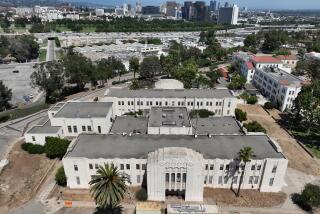First a Plan, Then a Solution to Transportation Problems
- Share via
Like other advocacy organizations across the country, the Valley Industry and Commerce Assn. (VICA) recently sent a delegation of local business executives to Washington, D.C., to build relationships with--and, we hope, influence--the nation’s key legislative decision makers.
In so doing, VICA ran the traps, meeting with the administration, Welfare to Work and the Department of Labor, among others.
However, when the group landed at the Federal Transit Administration, it encountered one not-too-happy camper: Gordon Linton, the FTA administrator.
Linton is in charge of intermodalism, Washington jargon for various integrated forms of transportation. He has the distinct pleasure of juggling more than $80 billion worth of projects submitted from communities vying for federal dollars. Unlike Los Angeles, these communities have coherent plans and the required minimum of more than 20% in local matching dollars.
Which brings us to Linton and the source of his unhappiness.
Los Angeles can barely write a plan, let alone pony up more than 20%. Additionally, the Metropolitan Transportation Authority has submitted three, count ‘em, three recovery plans. And all have been rejected.
This is not particularly good news because the MTA has to convince the feds--including Linton--that it has a viable plan to get out of bankruptcy, put its financial house in order, decide on route priorities, deal with a consent decree to improve service and keep the current system running.
Not an easy task, because many believe that the MTA is the transit version of the Titanic, except for the fact that even the ship only sank once. As most Angelenos know, the transit wars have been going on for more than 12 years. Our local, state and federal elected officials have all gotten into the fracas in the name of regional transportation, with little result.
The MTA has gone through two general managers, each averaging three years, in an impossible job dealing with a cantankerous board of directors, elected officials and a huge, disparate staff still fighting over the status of rail versus bus.
Over the years, VICA has dealt with the nuances and vagaries of every elected official in the Valley to find support for a line to provide real transit relief. It hasn’t been easy.
VICA supported light rail; the homeowners didn’t. VICA supported the subway; local legislators and the community waffled. Competition for dollars pushed the Valley to the end of the line until state legislation demanded tunneling. Then a freeway monorail concept surfaced; a controversy, and the funds dwindled away. And so on.
But back to Linton. One gets the distinct feeling that he would like to provide relief for the Valley’s growing population of transit-dependent people, but that he--like VICA--can’t do much until the MTA has a workable plan.
In the meantime, VICA is not waiting for external solutions to local transit problems.
VICA has supported a Valley transit zone and Valley transit authority. Either would go a long way toward fiscal autonomy for Valley-ista and local control.
It was worth the effort to travel to Washington to hear and see what Angelenos are up against. It isn’t pretty, but oftentimes reality isn’t. Bummer.
****
Valley Voices will return after the June 2 election.






